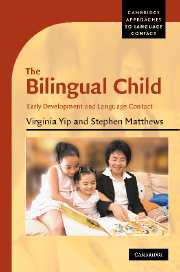Book contents
- Frontmatter
- Contents
- List of tables and figures
- Series editor's foreword
- Preface
- Acknowledgments
- List of abbreviations
- 1 Introduction
- 2 Theoretical framework
- 3 Methodology
- 4 Wh-interrogatives: to move or not to move?
- 5 Null objects: dual input and learnability
- 6 Relative clauses: transfer and universals
- 7 Vulnerable domains in Cantonese and the directionality of transfer
- 8 Bilingual development and contact-induced grammaticalization
- 9 Conclusions and implications
- References
- Index
- Author index
4 - Wh-interrogatives: to move or not to move?
Published online by Cambridge University Press: 08 January 2010
- Frontmatter
- Contents
- List of tables and figures
- Series editor's foreword
- Preface
- Acknowledgments
- List of abbreviations
- 1 Introduction
- 2 Theoretical framework
- 3 Methodology
- 4 Wh-interrogatives: to move or not to move?
- 5 Null objects: dual input and learnability
- 6 Relative clauses: transfer and universals
- 7 Vulnerable domains in Cantonese and the directionality of transfer
- 8 Bilingual development and contact-induced grammaticalization
- 9 Conclusions and implications
- References
- Index
- Author index
Summary
Child: It is for what?
Father: What is it for?
Child: What is it for what?
Child: It is for what?
Child: What is this for?
(Timmy 2;05;03)The above dialogue illustrates a striking aspect of Timmy's early English grammar: the wh-word in questions such as It is for what? remains ‘in-situ’ instead of moving to the sentence-initial position. When his father reformulates Timmy's question using wh-movement (what is it for?) Timmy responds with the wh-word both preposed and in situ (what is it for what?) in the same utterance, before reverting to the wh-in-situ version and finally arriving at the fronted form (what is this for?). As we show in this chapter, all four of our bilingual Cantonese-dominant children go through such a developmental stage in which wh-movement is optional in their English grammar, which can be attributed to transfer based on Cantonese wh-in-situ questions.
The acquisition of wh-interrogatives is fundamental to the child's developing grammar. Syntactically, simple single clause wh-questions form the basis of more complex structures involving multiple wh-questions and embedded clauses. The movement of wh-phrases involved in wh-questions is also hypothe-sized to be involved in other complex structures like relative clauses. Cognitively, it is important for children to learn to ask various forms of wh-questions to obtain information regarding objects and events (what questions), location (where questions), people around them (who questions), cause and effect relations (why and how questions) and time relations (when questions).
Information
- Type
- Chapter
- Information
- The Bilingual ChildEarly Development and Language Contact, pp. 87 - 132Publisher: Cambridge University PressPrint publication year: 2007
